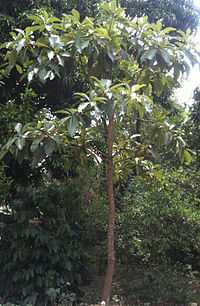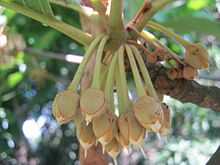Phulwara oil



Phulwara oil is extracted from the seeds of the Phulwara tree, which is also known as the Chiuri Tree or Butter Nut Tree in Nepal. It is part of the family Sapotaceae. The botanical name of the phulwara tree is Diploknema butyracea. Commercially, oil extracted from the seeds is marketed as Phulwara Ghee.
Habitat
Phulwara is native to Nepal. It commonly grows in the sub-Himalayan tract between 300 and 1500 meters above sea level. In India, it grows abundantly in the Pithoragarh district and adjoining areas of the Uttarakhand, Almora, Bageshwar and Nainital Districts.[1]
Tree
The phulwara is a medium sized deciduous tree with a straight trunk. It typically attains a height of 15 to 22 meters and a girth of 1.5 to 1.8 meters. In the Andaman Islands it can reach a height of 21 to 36 meters and a girth of 1.5 to 2.4 meters. In the hills of the Kumaun Region, the trees attains a girth of 3 meters. The bark is dark grey or brown.[2] The tree begins to bear fruit in 5 to 9 years, and continues to bear fruit up to 50 to 60 years, with maximum fruit-bearing happening about 15 years after germination or planting.[3]
Leaves
The leaves form clusters at the end of the branches. They may be pink or white in color, are elliptically shaped, and are 20 to 35 mm long by 9 to 18 cm width.
Flowers
The flowers, which are 2.0 to 2.5 cm in diameter, are white or pale yellow in color and have a sweet fragrance.
Fruit
The fruit is an oval shaped berry, 2.0 to 4.5 cm long, bright green or blackish, shiny with a thick, soft pericarp, ripening between the months of May and August. The fruits are edible and sweet and contain 8.5% sugars and 5.6% crude fiber. The seeds constitute 20% of the fruit.[3] The three seeds typically present in a single fruit are black and sparkling, 1.5 to 2.0 cm in length, with almond shaped white kernels containing saponins inside each seed. The seed coat varies from thin to thick, and woody to crusty. The seeds contain 42-47% oil and the kernel contains 60-66% oil. The weight of 100 seeds is 78 grams and the average annual fruit yield per tree is about 100 to 250 kilograms (220 to 551 lbs).
Seed collection
Ripened Phulwara fruits are collected by hand or by beating with locally made long bamboo sticks. The harvested fruits are dried in the shade for 8–12 days. Two methods are employed to separate seeds from fruits; manually and mechanically. If the quantity of the fruits are minimal, the fruits are crushed manually and the seeds are separated. In the case of a large quantity, roller machines are used. Crushed fruits are collected in a wide tray and seeds are collected in the lower end of the machine.
Oil extraction
Oil is extracted from the kernels of the Phulwara seeds. The outer shell of the seed is removed by a traditional method or a mechanical method. In the traditional method, the seeds are boiled with water and the softened seeds are placed on the floor and pressed until the kernels come out. In the mechanical system, the shell of the seed is removed by a decorticator machine.
After being cleaned and dried, the seeds are pounded into a fine powder using a traditional pounder, called a dhiki. The powder is steamed on a perforated plate over the boiling pan. The oil is then extracted using a traditional oil expeller called a chepuwa.[4] Presently, oil is extracted from the seeds using expellers.
Properties of oil
The oil has a bitter taste due to its high content of impurities, such as saponins, which accompany fat extracted from kernels. Post-extraction filtration or purification is necessary for the ghee to become edible.
Table-Physical characters of oil[5]
| character | range |
| Specific gravity,at 30°C | 0.856-862 |
| Refractive index.at 40° | 1.4552-1.4650 |
| Iodine value | 90-101 |
| Melting point | 31-51°C |
| R.M.value | 0.4-4.3 |
| Titer value | 48-52°C |
Composition of fatty acids
Phulwara oil contains 56.6% palmitic acid and 3.6% stearic acid, both of which are saturated fatty acids.It also contains 36.0% oleic acid along with 3.8% linoleic acid, both of which are unsaturated fatty acids. Oleic acid is a mono-unsaturated fatty acid and has one double bond at the 9th carbon of its hydrocarbon chain. Linoleic acid has two double bonds in the hydrocarbon chain of the acid.
Table-physical and chemical characters of fat [5]
| Fatty acid | Percentage |
| Palmitic acid(C16:0) | 56.6 |
| Stearic acid(C18:0) | 3.6 |
| Oleic acid(C18:1) | 36.0 |
| Linoleic acid(C18:2) | 3.8 |
Uses of oil
Phulwara/chiuri ghee/butter is the main source of edible oil for more than one hundred thousand people. Ghee is used to cook vegetables and roti (Nepali bread), Chiuri butter is used in confectionery, pharmaceutical, vegetable ghee production, candle manufacturing and soap making. It has been found to be effective for rheumatism. It is also used as an additive in animal ghee.[4]
See also
References
- ↑ "Extraction Of High Quality Dna From Diploknema Butyracea". sciencepub.net. Retrieved 2013-11-22.
- ↑ "cheura". novodboard.com. Retrieved 2013-11-22.
- ↑ 3.0 3.1 "PHULWARA". manoramagroup.co.in. Retrieved 2013-11-22.
- ↑ 4.0 4.1 "Chiuri - the Butter Tree of Nepal". appropedia.org/. Retrieved 2013-11-22.
- ↑ 5.0 5.1 "cheura= Phulware-". crirec.com. Retrieved 2013-11-22.
External links
| |||||||||||||||||||||||||||||||||||
